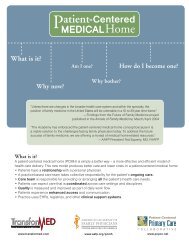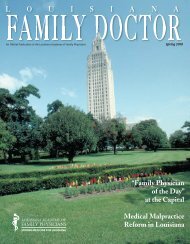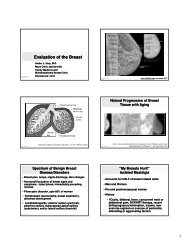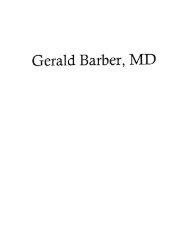New Drug Update 2009-2010 - LAFP
New Drug Update 2009-2010 - LAFP
New Drug Update 2009-2010 - LAFP
Create successful ePaper yourself
Turn your PDF publications into a flip-book with our unique Google optimized e-Paper software.
alendronate (mean prior exposure, 4 years) were randomized to receive zoledronic acid 5 mg as a single<br />
infusion plus 52 weeks of oral placebo (113 patients) or placebo infusion plus 52 weeks of oral<br />
alendronate 70 mg (112 patients). Bone biopsy revealed nearly identical effects on static and dynamic<br />
histomorphometric measures. BMD values did not differ between groups. Annual infusion was preferred<br />
overall by 78.7% of patients; the once-a-week oral dosing was preferred by 9%. Substantially more<br />
patients expressed the preference that the infusion was more convenient (79.2% vs 7.2%), the infusion<br />
fits their lifestyle better (72.4% vs 8.1%), and they would be willing to take it for a longer period of time<br />
(71.5% vs 9%). 28th Annual Meeting of the American Society for Bone and Mineral Research; September<br />
15–19, 2006; Philadelphia, PA. Abstract SA357.and Abstract SU329.<br />
The efficacy of zoledronic acid injection administered annually in the prevention of new clinical fracture is<br />
also being assessed in a randomized, double-blind, placebo-controlled study enrolling 2,128 patients 50<br />
years of age and older who have undergone surgical repair of a low-trauma hip fracture in the preceding<br />
90 days (HORIZON-Recent Hip Fracture Trial RFT).N Engl J Med 2007;357: online 9/17/07.Mean age<br />
was 74.4 years, and 76.1% were female. A prior osteoporotic fracture was reported for 45.3% of patents.<br />
Patients received IV zoledronic acid 5 mg annually or placebo infusion annually. All patients received<br />
vitamin D orally as a loading dose, followed by 800 units vitamin D3 and calcium carbonate 1,000 mg<br />
daily. Concomitant therapy with calcitonin, hormone replacement therapy, selective estrogen receptor<br />
modulators, tibolone, and external hip protectors was permitted. The primary study end point was<br />
subsequent skeletal fractures; patients will be followed until 211 fractures have been reported. Secondary<br />
outcomes included changes in BMD and health resource utilization. The rates of any new clinical fracture<br />
were 8.6% in the zoledronic acid group and 13.9% in the placebo group, a 35% risk reduction with<br />
zoledronic acid (P = 0.001); the respective rates of a new clinical vertebral fracture were 1.7% and 3.8%<br />
(P = 0.02), and the respective rates of new nonvertebral fractures were 7.6% and 10.7% (P = 0.03). In the<br />
safety analysis, 101 of 1054 patients in the zoledronic acid group (9.6%) and 141 of 1057 patients in the<br />
placebo group (13.3%) died, a reduction of 28% in deaths from any cause in the zoledronic acid group (P<br />
= 0.01). The most frequent adverse events in patients receiving zoledronic acid were pyrexia, myalgia,<br />
and bone and musculoskeletal pain. No cases of osteonecrosis of the jaw were reported, and no adverse<br />
effects on the healing of fractures were noted. The rates of renal and cardiovascular adverse events,<br />
including atrial fibrillation and stroke, were similar in the two groups.<br />
CONTRAINDICATIONS: The contraindications, warnings, and precautions for zoledronic acid are similar<br />
to those of IV ibandronate and pamidronate. Zoledronic acid is contraindicated in patients with clinical<br />
hypersensitivity to zoledronic acid monohydrate or other bisphosphonates, or any of the excipients in the<br />
injectable formulation (mannitol, sodium citrate). When used in the treatment of osteoporosis and Paget<br />
disease, zoledronic acid is also expected to be contraindicated in patients with uncorrected<br />
hypocalcemia. Table 4 compares the contraindications associated with injectable ibandronate,<br />
pamidronate, and zoledronic acid.<br />
Table 4. Comparison of Contraindications Associated With Ibandronate, Pamidronate and<br />
Zoledronic Acid Therapy<br />
Contraindications Ibandronate Pamidronate Zoledronic Acid<br />
Hypersensitivity to the product X X X<br />
Hypersensitivity to other bisphosphonates X X<br />
Uncorrected hypocalcemia<br />
X<br />
WARNINGS AND PRECAUTIONS: Because of the potential for renal toxicity, zoledronic acid should not<br />
be administered at doses higher than the approved dosage, and the duration of infusion should be no<br />
less than 15 minutes. In clinical trials, the risk of renal function deterioration was increased in patients<br />
who received zoledronic acid over 5 minutes, compared with patients who received the same dose over<br />
15 minutes. The risk of renal function deterioration and renal failure was also increased in patients<br />
receiving an 8 mg dose, even when it was administered over 15 minutes.<br />
The FDA reviewed spontaneous post-marketing reports of atrial fibrillation reported in association with<br />
oral and intravenous bisphosphonates and did not identify a population of bisphosphonate users at<br />
increased risk of atrial fibrillation. In addition, as part of the data review for the recent approval of onceyearly<br />
Reclast for the treatment of postmenopausal osteoporosis, the FDA evaluated the possible<br />
association between atrial fibrillation and the use of Reclast. Most cases of atrial fibrillation occurred more<br />
44

















